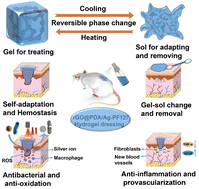A cooling-driven self-adaptive and removable hydrogel coupled with combined chemo-photothermal sterilization for promoting infected wound healing†
Abstract
Hydrogel dressings that can fit irregular wounds, promote wound healing, and detach from wounds without damage represent the development trend of modern medical dressings. Herein, a novel composite hydrogel with excellent wound shape matching and painless removability via a gel–sol phase transition is constructed through dynamic borate ester bonds between phenylboronic acid-grafted F127 (PF127) and polydopamine-coated reduced graphene oxide/silver nanoparticles (rGO@PDA/Ag NPs). After contact with the skin tissues, the administered liquid-like sols gradually transform into solid-like gels, robustly adhering to the wound. The hydrogel dressings containing near-infrared (NIR)-responsive rGO@PDA and in situ formed Ag NPs can generate localized heat and gradually release Ag+ to realize safe, effective, and durable photothermal-chemical combined sterilization. In addition, catechol-rich PDA endows the hydrogel dressings with good antioxidant activity and adhesiveness. In vivo study results indicate that the hydrogel dressings can significantly accelerate full-thickness skin infected wound healing by eliminating bacteria, promoting collagen deposition and angiogenesis, as well as reducing inflammation. Collectively, the thermoreversible rGO@PDA/Ag-PF127 hydrogel dressings with an improved self-adapting ability, superior antimicrobial activity, and tunable adhesion appear to be a promising candidate for the treatment of infected wounds.



 Please wait while we load your content...
Please wait while we load your content...